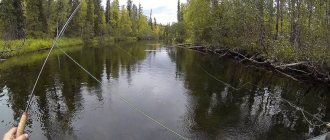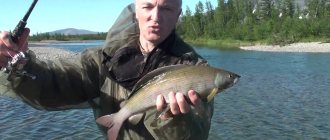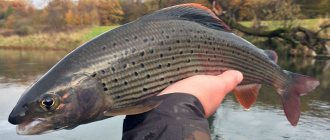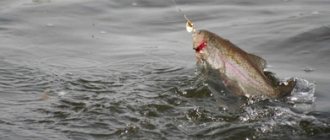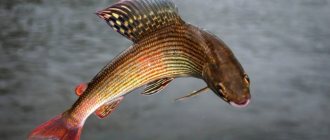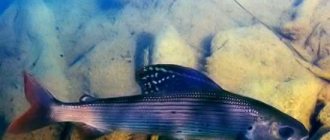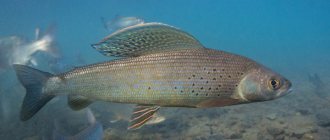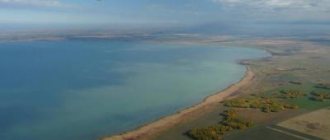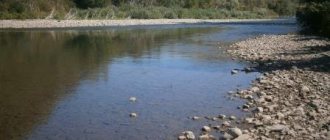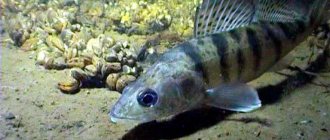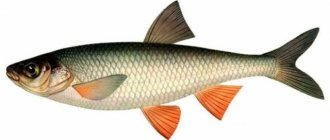Grayling is a member of the salmon family and is a very valuable catch for many anglers. You can catch it at different times of the year; autumn is considered the most successful choice, since only the most experienced fishermen can afford to go fishing for grayling in the summer.
This is due to the unpredictability of fish behavior, since there is a lot of different food in reservoirs, and choosing the right bait and tackle to get an impressive catch can be very difficult. This article will answer all the basic questions related to catching this type of prey in the summer.
Choosing fishing gear
Types of gear for summer grayling fishing
Initially, you need to decide on the gear itself that will be used to catch this prey. All main options are discussed below:
- A float rod is usually used in the spring, when the grayling fishing season opens. The water at this time of year is usually still cloudy and this type of gear is the best option, but you can continue to use it in the summer. The only requirement is the light weight of the rod itself, since wiring will mean that the rod is constantly in the hands of the fisherman and an incorrectly selected model can lead to premature fatigue. The ideal solution would be a telescopic float rod made of carbon fiber; the length of the rod should be no more than 5-6 meters.
- Modified float tackle designed for surface fishing. You can get such tackle using special equipment.
- Fly fishing gear is another good option for summer grayling fishing. Today, such fishing is not very common, since it requires the angler to be in the water, and this requires additional expenses for special waterproof clothing. In addition, casting flies with such tackle is a rather difficult task, which requires long training.
- A sleigh or boat is a piece of equipment that was once very popular, but then was forgotten, but today there is a revival of interest in it. Its operating principle is quite simple: a structure made of any type of floating material is connected to a fishing rod and used to send it to the opposite shore of the reservoir. This technique is especially effective if the potential prey is located in the middle of the river, where it is impossible to cast with a fishing rod.
- Spinning is also very often used for summer grayling fishing, but only ultralight models are suitable for such purposes. The optimal rod length varies from 2 to 2.7 meters; this figure usually depends on the characteristics of the shore from which you plan to cast.
Fly fishing gear is another good option for summer grayling fishing
Equipment for float rod
A float rod is one of the most popular options for fishing for grayling in the summer; its demand is due to its ease of use.
There shouldn't be a problem with the rig either, it should look like this:
- The type of reel is not particularly important ; the only requirement for it is the ease of rotation of the drum, which should be carried out under the influence of the force of the current.
- A nylon cord with a diameter of no more than 0.2 mm is used as a working line .
- The leash should also be made of nylon , but its diameter should not exceed 0.16 mm.
- There are two requirements for the float: its carrying capacity must be 2-4 grams, and its color and size must be such that it is visible to the fisherman even at a very long distance.
- You can use a regular single hook, sizes from No. 10 to No. 14 are suitable, depending on the size of the intended prey. You can solder a little lead on the forend, then you will get a homemade jig, which will allow you to avoid using an additional sinker.
Fly fishing equipment
Fly fishing requires from the fisherman not only certain training and the availability of appropriate skills, but also special attention when choosing equipment.
For this method you will need to prepare:
- A suitable rod should be suitable for surface fishing.
- Conical cord.
- Coil. The type of this device is not particularly important; its light weight is much more important.
Otherwise, the equipment does not have any fundamental features; it will be much more difficult to select flies. It is advisable to have a whole set with you, since grayling responds best to those options that are most similar to its food included in its daily diet.
Equipment for surface-type float fishing rod
Such gear is usually homemade models, converted from standard float rods. However, the equipment for them will have some individual features:
- Any reel can be used , but it must be capable of providing a supply of working line of at least 50 meters.
- The diameter of the monofilament used should be within 0.16-0.2 mm.
- Floats are usually used homemade, they are made from wine cork: such a device will have the optimal weight, size and at the same time remain invisible to mining. The upper part of the float is additionally equipped with a lead plate, which will serve as a weight.
- Hooks are selected depending on the expected size of the grayling ; any single models No. 12-14 are suitable.
Hooks are selected depending on the expected size of the grayling
Equipment for a sleigh or boat
When choosing a sled or boat for fishing for grayling, you will need to prepare the following equipment and devices:
- The structure, which will be responsible for transporting the equipment , the most suitable material for it is foam plastic or fairly light wood.
- To connect the structure to the main gear, it is necessary to use a strong fishing line, the diameter of which must be at least 0.4-0.5 mm.
- A prerequisite is the use of a float with a cross-section of no more than 0.16-0.2. It should be attached approximately 20-30 cm from the fishing line to connect to the structure.
- Single hook No. 12-14 is attached directly to the float.
Spinning equipment
The last gear option is an ultra-light spinning rod with flexible blanks, which will simplify the casting process.
The equipment for it should look like this:
- Multiplier reel , the main requirement is small dimensions and low weight of the device.
- The diameter of the monofilament should be 0.14-0.16 mm, but when using braided cord it should be reduced to 0.08-0.1 mm.
Promising places for grayling fishing on a small river
Catching grayling with float tackle using artificial flies involves floating the bait and holding it for several minutes. Note that after casting, the fly moves along an unpredictable trajectory, the bait performs actions that are as similar as possible to the behavior of the insect that the fish feeds on at a specific period of time.
After casting, the bait should be in a free position, that is, the main line should not be stretched to the limit. Therefore, when floating the fly to a promising place, you should monitor the weakening. In this case, the grayling is more likely to make an attack, it will have sufficient margin to make a turn, and the angler will have a few seconds in reserve to make a hook.
A good place for fishing can be noted in the area below a steep rift, where a small backwater with a reverse current is formed. Here the equipment will slowly move in a circular line; if there is an active fish in the zone, the bite will follow immediately.
You can try to catch grayling in the area between fast and slow streams with the presence of a whirlpool. In such a place, you do not need to monitor the state of the line tension; just look carefully at the bite indicator, which is the float, and as soon as it changes position and begins to sink, a hook should follow. You can meet trophy grayling behind large stones, where the fish stands below the current and waits for prey. In a word, any area away from the main stream can be a promising area for catching grayling in the summer. Depth in this case will not matter much.
Read: Tackle for fishing grayling
In conclusion, when choosing a fishing location, we note that grayling is very careful; even the shadow of a fishing rod can alert it. Therefore, you should try to cast the bait as carefully as possible, and if circumstances permit, then this should be done from behind cover.
Lures
Natural baits
In summer, natural baits are mostly used; effective options can be:
- Various insects that live outside the reservoir, for example, grasshoppers, flies or flies. Grayling responds best to them during settled hot weather.
- Various invertebrates inhabiting the pond in which grayling lives. The main advantage of such bait will be that it is food familiar to fish and will not cause any special suspicion.
- Earthworms and dung worms are usually used during spring fishing, but in summer grayling often respond well to such bait. Worms are the best option if you plan to use a float fishing rod.
Artificial baits
Artificial baits are used when using spinning rods. For catching grayling in the summer, the following have proven themselves to be positive:
Mepps Aglia are French spinners of very high quality; you must use models whose size is 00-1.
Panther Martin, size No. 1. This bait is a non-hooking lure, it is light in weight, but at the same time it is well suited for fishing in areas of a reservoir with a rapid flow, since it has the ability to withstand even the strongest water flows.
Blue Fox is a spinner bait that comes in a variety of colors; you need to select them depending on the weather conditions in which you will be fishing.
Yo-Zuri Snap Beans is a small wobbler with a working depth of 50 cm, which makes it ideal for summer grayling fishing.
Anglers Republic produces the BM-20 and 25SR wobbler models, which are small but voluminous fats. They are usually used when the bite is bad, since such bait provokes even the most passive predator to attack.
Grayling and jig baits: are they compatible?
Extraordinary river
Despite the fact that the Yuryuzan flows in the Ural Mountains, there are also sections of a classic mountain river on it - shallow rocky rifts, small rapids and elements characteristic of a lowland river - wide reaches with a slow flow, whirlpools.
Areas with fast-flowing water are abundantly overgrown with various aquatic plants, leaving only the fairway free. To my surprise, the grayling stayed not only on the riffles, but also on the reaches, in the pools, and also on the border of aquatic vegetation on the fairway. Spinner baits and wobblers did their “job” perfectly on the rifts and reaches, but among the thickets of aquatic plants and in the pools they turned out to be untenable. Then I tried jigs. The average depth of the pools on Yuryuzan is no more than 2–2.5 m. The bottom is rocky, snags are extremely rare, which allows the use of rigs with open hooks.
To reduce the sinker getting caught on stones, it is better to use not jig heads, but a double hook hinged to a grub or oktopus and an “eared” sinker. I am not a fan of serious color selection of jig baits, but the best results were clearly shown by baits of white, pearl and gray colors. Strangely enough, the black ones were in second place in terms of catchability.
Light-colored hair baits also show very good results. Such “streamers” are rarely found on sale, but it is very easy to make yourself from a bunch of light synthetic fibers, a pair of feathers and a single or double hook with a long shank. It is best to start fishing for whirlpools from the highest point, so that the bait, when retrieving, is carried by the current to the beginning of the slope into the depths.
The bite most often occurs when the bait falls into the bottom depression (that is, the grayling “stands” on the slope itself).
If there is no bite when casting at the upper edge of the pool, the next casts are made lower and lower downstream. At the deepest point of the pool, bites are rare, and most often perch and pike grab the bait there. Grayling, as a rule, begins to be caught again at the exit from the pool.
The largest number of bites occur during a pause, but it is necessary to alternate the classic “step” with horizontal uniform wiring above the bottom - sometimes, for reasons unknown to me, grayling clearly prefers this kind of wiring. The grayling bite is sharp, “brazen”, reminiscent of a pike perch strike; it always swallows the bait deeply.
A good alternative to a soft bait with a “eared” sinker is a tail spinner. Its color is not decisive, but light-colored baits tend to get more bites. A tail spinner should be chosen with the smallest petal, but one that works (the petal should rotate and not oscillate - this is important), and the heaviest possible body.
The weight is preferably twenty percent heavier than that of a conventional jig head, which ensures high-quality wiring in these conditions. Why, in this case, are jig baits preferable to wobblers and spinners? The wobbler does not allow it to be “dumped” into the pool, so we cannot fish the most promising zone, but the usually used spinners do not reach the bottom in the pool - they are simply carried away.
Also interesting: Fishing from a boat
On the fairway among the grass
The strip of water free from vegetation in the middle reaches of the Yuryuzan is about 5–10 m. In those areas where the current and depth allow you to enter the water, there is no point in fiddling with jig baits - just stand in the middle of the river and fish with heavy rotating spoons, moving them Wipp, Agat and other Myran spinners show excellent results ).
However, if you don’t have a wading suit (and you can’t survive more than 10 minutes in Yuryuzan without it) or the depth does not allow you to stand in an interesting fishing area, then you have to use non-snagging jig rigs. The main reason for using non-hooking baits is that, having cast into a strip of clear water on the fairway and made a 5-7-meter retrieve, you will have to drag the bait through 15 m of thick algae, which strives to “keep” your wobbler or spoon as a souvenir .
After trying various options, I finally settled on the Texas rig. Unlike the classic American version, we need heavy (at least 15-18 g) lead (not steel or brass) weights. You can now find already assembled bullet-shaped lead weights with an offset hook on sale. They will fit perfectly, you just need to choose the option with a heavy sinker and a small “offset” - size no more than 00 according to the international classification.
If you were unable to purchase something like that, don’t worry, you can use half or two-thirds of an “olive”, in the flat surface of which you need to make a hole with a regular drill - the hinge joint of the offset hook will go there. The hinge is more convenient than the sliding version, so it is optimal to use it.
Insert a piece of stainless wire into the ring of the offset hook, twist it a few turns, then insert it into the axial hole of the “olive” and form a small ring to which the fishing line will be attached.
It is best to use a medium-sized (70–80 mm) light-colored plastic worm with an active tail as bait. Bites also happen on larger baits, but the percentage of their sales is close to zero - the grayling is simply not detected. Even when using relatively large baits, catching one or two fish per dozen bites should be considered an excellent result.
The fishing technique is very simple
— cast across the current, trying to get the bait into the strip of weeds on the opposite side of the fairway (you shouldn’t cast far, just a couple of meters from the edge). Then they “pull” the bait through the grass and, as soon as it hits the edge of the clearing, they begin the slowest stepwise retrieve, trying not to lift the bait more than 30–35 cm from the bottom, that is, practically “drag” it along the bottom.
Also interesting: Usach
Most often, bites occur when the bait comes out of the grass (at the first meter) and when it approaches the edge of the algae from the opposite side. I never had a bite in the middle of the fairway.
If there is no bite, and the bait has already entered the thickets of aquatic plants, it makes sense to jerk it to the surface and, holding the rod vertically, simply reel out the line as quickly as possible - there is no chance of grayling biting in the thick grass.
The bites are much less decisive than when fishing in pools, reminiscent of fine “crushing”. Until you get the hang of it, it’s better to hook on any suspicious push - otherwise, given the very low percentage of realization of even obvious bites, there is a chance of returning from the river empty.
You need to fish fairway nets very carefully, shifting each cast literally half a meter - often bites occur in areas located at a distance of about 1 m from each other. If you make wider casting steps, you can miss many potential bites.
A few subtleties
Grayling
is a very cautious and timid fish, so the tackle for catching it should be as inconspicuous as possible. It is not without interest that when fishing with rotating spoons and wobblers, grayling reacts very reluctantly to baits attached to “braid” of bright colors, giving a clear preference to transparent and thin monofilament.
When fishing with jig baits, grayling is much less picky in relation to fishing line - I caught it very well on FireLine in pink color - while new, it literally “glows” in the water, but the fish did not distinguish between it and monofilament fishing line. Well, in terms of sensitivity, naturally, braided line is better, especially when the grayling bites slowly and hesitantly.
The use of a metal leash, even the softest one, clearly has a negative effect on grayling fishing. And since a certain percentage of bites are pike, you have to put up with the loss of a certain amount of bait, since with a leash, grayling bites, which are already not particularly frequent, simply stop.
In conclusion, I would like to note that jig baits are not a panacea for grayling fishing, and, apparently, never will be. The algorithm proposed in this article operates only in certain conditions, when tried and true commonly used baits (wobblers, oscillating and rotating spoons) are “out of use.” I hope it helps you if you find yourself in a similar situation.
Features of grayling fishing
After the suitable tackle and all other devices have been selected, all that remains is to become familiar with the main features of catching this type of fish.
In the summer they are usually as follows:
- Grayling is characterized by a fairly fast bite , so at the first sign of it, an equally rapid hooking should be carried out.
- When approaching the fishing site, it is necessary to maintain silence , since grayling is a rather shy prey and reacts to all loud sounds.
- It is best to throw the bait at a short distance from the fishing point; the current should deliver it to it. It is advisable that the fisherman himself be in shelter.
- When in the water, you need to stand with your back relative to the direction of the current , this will allow the bait to move to the most successful area with mud raised from the bottom, which will certainly attract potential prey.
- When the bite level decreases, you must carefully move to the neighboring area , remembering to remain quiet. If fishing is carried out below the riffle, then with careful movements of the foot you can slightly loosen the sand on the surface of the bottom, which will help attract prey.
- When fishing for grayling in fast-flowing rivers, you need to find a section of a reservoir with calmer water, and then make a point cast from a long distance.
How to catch grayling with flies: choosing bait, setting up tackle
You can start fishing for grayling immediately after the end of spawning. It has been noticed that large individuals are the first to leave the spawning grounds; they quickly move from the upper reaches of the river downstream to their usual summer places. It is much more convenient to catch grayling at the beginning of summer than, for example, in the middle of the season. Why? This is explained by the spring flood, which reduces water transparency, causing grayling to become less cautious.
You can catch grayling in June with less care; bites from this fish often occur even just a few meters from the angler’s feet. Of course, despite this, certain camouflage requirements should be observed, since this somewhat increases the chances of catching a trophy specimen, which, even in such conditions, does not cease to forget about its own safety.
To catch grayling with a float rod using artificial flies, special attention should be paid to the choice of float. It is recommended to purchase options with a load capacity of 4-5 grams, which are made of ordinary foam. It is important to use floats that are not painted in bright colors, this can alert the fish, especially when fishing in clear water. An excellent solution would be to use a goose feather float, the appearance of which will not cause the slightest danger to the fish. You can fix the proposed bite alarms on the main line using a piece of nipple.
Read: How to catch grayling in winter
A special feature of the equipment for catching grayling is the method of loading. It is important to give the bait maximum freedom; this can be easily adjusted by the length of the leash. So, it is proposed to divide the weight of the load into three unequal parts. Fixation is carried out from the float at a distance of 5-7 cm every 5 cm. The result will be a sufficient leash length even when fishing for grayling in an area with a depth of 0.5-0.7 meters. If the fishing process is carried out in an area with a depth of more than 1.5 meters, then the surface of the float can be covered with black paint, this will increase its visibility at a distance from the fishing point of more than 20 meters.
Blitz tips
To summarize, we can give the following tips that will be useful to anglers when fishing for grayling in the summer:
- Flies for fishing grayling
To fish for large prey and trophy specimens, it is necessary to fish in deep areas. Large grayling, even in summer, does not like to rise too close to the surface of the water, where its smaller relatives live.
- The floats that are used to rig fishing rods for grayling should be visible to the angler from afar, but the use of too bright devices is not allowed. This is more likely to scare off such wary prey.
- Before choosing natural bait, it is recommended to study the features of a particular reservoir in order to have an idea of what grayling is used to feeding in these places. However, in any case, it is recommended to have a set of different attachments with you, since this breed is characterized by increased capriciousness when choosing food, and it is often impossible to predict its preferences.
